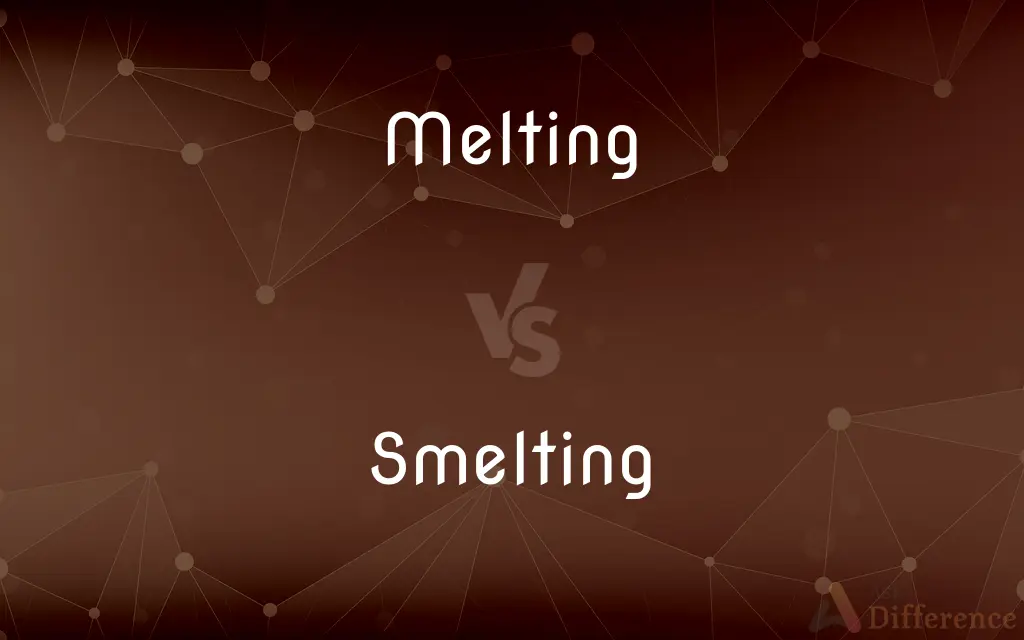Melting vs. Smelting — What's the Difference?
By Tayyaba Rehman & Urooj Arif — Updated on March 19, 2024
Melting is the process of turning a solid into a liquid by heating it above its melting point, while smelting involves heating ore to extract metal, often requiring a chemical reducing agent.

Difference Between Melting and Smelting
Table of Contents
ADVERTISEMENT
Key Differences
Melting is a physical change where a solid becomes a liquid when heated to its melting point, applicable to any solid material like ice turning into water. Smelting, on the other hand, is a metallurgical process used specifically for extracting metals from their ores by heating beyond the melting point, often involving a chemical reaction to remove non-metallic elements.
In melting, the substance changes state but retains its chemical composition, such as solid gold melting into liquid gold. In contrast, smelting changes the chemical composition of the ore to separate the metal, producing a distinct substance, like turning iron ore into pure iron.
Melting can occur at various temperatures depending on the substance's melting point, which is a specific physical property. Smelting temperatures and conditions vary widely depending on the metal being extracted and the presence of impurities, often requiring much higher temperatures and the addition of a reducing agent like coke.
While melting is widely used in both industrial applications and everyday scenarios (e.g., melting butter for cooking), smelting is a specialized process used primarily in the metal extraction and refining industry, requiring specialized equipment and facilities.
The purpose of melting is often to change the form of a material for various uses, such as molding or shaping, whereas the goal of smelting is to extract usable metal from ores, which is a critical step in the production of metal for manufacturing and construction.
ADVERTISEMENT
Comparison Chart
Definition
Turning a solid into a liquid by heating
Heating ore to extract metal with a chemical agent
Process Type
Physical change
Chemical process
Chemical Composition
Unchanged
Altered to remove impurities
Typical Use
General (e.g., cooking, molding)
Metal extraction and refining
Temperature
Depends on material's melting point
High, varies with ore and metal
Equipment
General heating tools
Specialized furnaces and chemical reducers
Compare with Definitions
Melting
Used in everyday and industrial applications.
Melting plastic for molding into new shapes.
Smelting
Central to the metal production industry.
Copper smelting furnaces produce pure copper for electrical wiring.
Melting
Retains the substance's chemical composition.
Melting chocolate turns solid bars into liquid without changing its chemistry.
Smelting
Extracts metals from ores.
Smelting iron ore to produce iron.
Melting
Can be reversed by cooling.
Melted wax solidifies when cooled.
Smelting
Results in a change of chemical composition.
Smelting bauxite ore into aluminum.
Melting
A physical change from solid to liquid.
Ice melts into water at 0°C.
Smelting
Requires high temperatures and reducing agents.
Using coke in smelting to reduce iron oxide to iron.
Melting
Occurs at the substance's melting point.
The melting point of silver is 961.8°C.
Smelting
Involves chemical reactions to remove impurities.
Adding limestone as a flux in smelting to remove impurities.
Melting
Melting, or fusion, is a physical process that results in the phase transition of a substance from a solid to a liquid. This occurs when the internal energy of the solid increases, typically by the application of heat or pressure, which increases the substance's temperature to the melting point.
Smelting
Smelting is a process of applying heat to ore in order to extract a base metal. It is a form of extractive metallurgy.
Melting
To be changed from a solid to a liquid state especially by the application of heat.
Smelting
To melt or fuse (ores) in order to separate the metallic constituents.
Melting
To dissolve
Sugar melts in water.
Smelting
To melt or fuse. Used of ores.
Melting
To disappear or vanish gradually as if by dissolving
The crowd melted away after the rally.
Smelting
A past tense and a past participle of smell.
Melting
To pass or merge imperceptibly into something else
Sea melted into sky along the horizon.
Smelting
Present participle of smelt
Melting
To become softened in feeling
Our hearts melted at the child's tears.
Smelting
(metallurgy) The process of melting or fusion, especially to extract a metal from its ore.
Melting
(Obsolete) To be overcome or crushed, as by grief, dismay, or fear.
Melting
To change (a solid) to a liquid state especially by the application of heat.
Melting
To dissolve
The tide melted our sand castle away.
Melting
To cause to disappear gradually; disperse.
Melting
To cause (units) to blend
"Here individuals of all races are melted into a new race of men" (Michel Guillaume Jean de Crèvecoeur).
Melting
To soften (someone's feelings); make gentle or tender.
Melting
A melted solid; a fused mass.
Melting
The state of being melted.
Melting
The act or operation of melting.
Melting
The quantity melted at a single operation or in one period.
Melting
A usually open sandwich topped with melted cheese
A tuna melt.
Melting
Present participle of melt
Melting
Which is melting, dissolving or liquefying.
Melting
Given over to strong emotion; tender; aroused; emotional, tearful.
Melting
That causes one to melt with emotion; able to make others feel tender and emotional.
Melting
The process of changing the state of a substance from solid to liquid by heating it past its melting point.
Melting
(figurative) The act of softening or mitigating.
Melting
Liquefaction; the act of causing (something) to melt, or the process of becoming melted.
Melting
Causing to melt; becoming melted; - used literally or figuratively; as, a melting heat; a melting appeal; a melting mood.
Melting
The process whereby heat changes something from a solid to a liquid;
The power failure caused a refrigerator melt that was a disaster
The thawing of a frozen turkey takes several hours
Melting
Becoming liquid
Common Curiosities
Why is smelting important in metal production?
Smelting is crucial for separating valuable metals from their ores, making them usable for various applications.
What is the main difference between melting and smelting?
Melting is a physical change that turns a solid into a liquid, while smelting is a chemical process that extracts metal from ore.
What are some examples of materials that can be smelted?
Iron, copper, aluminum, and lead are examples of metals commonly extracted through smelting.
What role does a reducing agent play in smelting?
The reducing agent donates electrons to the metal ions, enabling the metal to separate from its ore.
Can melting occur at room temperature?
Yes, for substances with a melting point below room temperature, such as certain fats or gallium.
Can the principles of smelting be applied to non-metallic substances?
While the term "smelting" specifically refers to metal extraction, similar principles of heat and chemical reduction are used in other processes.
Why is melting significant in recycling processes?
Melting is a key step in recycling as it allows materials to be reshaped into new products without altering their basic properties.
How do smelting temperatures compare to melting temperatures?
Smelting temperatures are generally higher than melting points because they must facilitate both melting and the chemical reactions needed to extract metal.
Does melting change the substance's chemical properties?
No, melting does not alter the chemical composition of a substance, only its physical state.
Is smelting an environmentally friendly process?
Traditional smelting can be energy-intensive and polluting, but modern techniques aim to reduce environmental impact.
Can every metal be smelted?
While most metals can be smelted, the specific conditions and processes required vary significantly depending on the metal's properties.
How has smelting technology evolved over time?
Smelting technology has advanced from simple charcoal-based furnaces to complex electrical and chemical processes, significantly improving efficiency and reducing environmental impact.
What is slag, and how is it produced?
Slag is a byproduct of smelting, consisting of waste materials and impurities separated from the metal during the process.
How do safety measures differ between melting and smelting?
Safety measures for smelting are more stringent due to the higher temperatures and toxic chemicals involved, compared to the generally lower risks associated with melting.
What advancements have been made in smelting processes?
Modern advancements include the development of less energy-intensive methods and the capture of emissions to minimize environmental damage.
Share Your Discovery

Previous Comparison
Bread vs. Dough
Next Comparison
Excel vs. AccessAuthor Spotlight
Written by
Tayyaba RehmanTayyaba Rehman is a distinguished writer, currently serving as a primary contributor to askdifference.com. As a researcher in semantics and etymology, Tayyaba's passion for the complexity of languages and their distinctions has found a perfect home on the platform. Tayyaba delves into the intricacies of language, distinguishing between commonly confused words and phrases, thereby providing clarity for readers worldwide.
Co-written by
Urooj ArifUrooj is a skilled content writer at Ask Difference, known for her exceptional ability to simplify complex topics into engaging and informative content. With a passion for research and a flair for clear, concise writing, she consistently delivers articles that resonate with our diverse audience.
















































